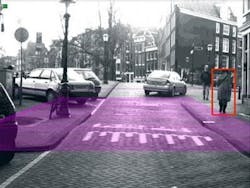Stereo 3-D cameras locate pedestrians for Daimler
With the help of a lecturer at the University of Alcalá (UAH; Madrid, Spain), a team of German researchers has developed a stereo vision system that locates pedestrians in front of a vehicle.
“The new system can detect pedestrians from within vehicles using visible spectrum cameras and can do so even at night,” says Professor David Fernández Llorca from UAH, who worked with scientists from the University of Heidelberg and the Max Planck Institute for Informatics to develop the prototype system for German auto maker Daimler.
The system itself employs a dense stereo matching technique whereby it tries to match as many pixels as possible from two cameras. Such dense stereo vision systems allow for more precise real-time recognition of the surroundings in front of the vehicle than so-called non-dense, or sparse, systems which pick distinct features in the images and attempt to match them.
The researchers also claim that pedestrian recognition is improved by a factor of up to 7.5 compared to such sparse systems. In the new system, for example, a child who suddenly runs across the road can be detected in less than 200 ms.
The two cameras themselves are connected to a processing unit based on field-programmable gate array (FPGA) technology, which executes the vision algorithms that perform the image matching, analysis, and classification. Images from the cameras can also be seen live on a screen in the car or projected on the inside of the windshield.
A complete technical article describing the system can be found at
http://www.gavrila.net/tits11_dense_stereo.pdf.
-- By Dave Wilson, Senior Editor, Vision Systems Design
